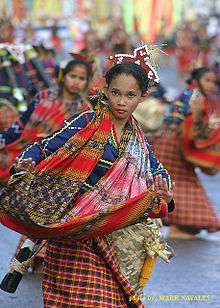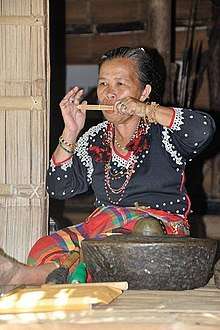Blaan people
The Blaan people,[9] alternatively spelled as "B'laan,"[10][11] are one of the indigenous peoples of Southern Mindanao in the Philippines. Their name could have derived from "bla" meaning "opponent" and the suffix "an" meaning "people." Other terms used to refer to this group are Blaan, Bira-an, Baraan, Vilanes, and Bilanes.


 | |
| Total population | |
|---|---|
| 301,620[1] (2010) | |
| Regions with significant populations | |
Soccsksargen, Davao | |
| Sarangani | 120,954[2] |
| Davao del Sur | 89,949[3] |
| South Cotabato | 48,391[4] |
| General Santos City | 20,769[5] |
| Sultan Kudarat | 9,078[6] |
| North Cotabato | 5,988[7] |
| Davao City | 3,285[8] |
| Languages | |
| Blaan, Cebuano, Filipino | |
| Related ethnic groups | |
| Lumad, Bajau, Moro, Visayans, Filipinos, and Austronesians | |
Classification
The Blaan are neighbors of the Tboli, and live in Lake Sebu and Tboli municipalities of South Cotabato, Sarangani, General Santos City, the southeastern part of Davao and around Lake Buluan in North Cotabato. They are famous for their brassworks, beadwork, and tabih weave. The people of these tribes wear colorful embroidered native costumes and beadwork accessories. The women of these tribes, particularly, wear heavy brass belts with brass "tassels" ending in tiny brass bells that herald their approach even when they are a long way off.
History
Some Blaan natives were displaced when General Santos City was founded in 1939. Others settled in the city.
Their language is said to be the source of the name for Koronadal City, from two Blaan words – kalon meaning cogon grass and nadal or datal meaning plain, which aptly described the place for the natives. On the other hand, Marbel, which is another name for the poblacion, is a Blaan term malb-el which means "murky waters" referring to a river, now called Marbel River.
The tribe practices indigenous rituals while adapting to the way of life of modern Filipinos.[12]
Relations with settlers and their descendants are not always harmonious; Ilonggo settlers reportedly clashed with some Blaan natives in March 2015.[13]
Arts and culture
Language
Indigenous Blaan religion
Some of the deities in the Blaan pantheon include:
- Melu – The Supreme Being and creator. He has white skin and gold teeth. He is assisted by Fiuwe and Tasu Weh.
- Sawe – Joined Melu to live in the world
- Fiuwe – A spirit who lived in the sky.
- Diwata – A spirit who joined Fiuwe to live in the sky
- Tasu Weh – The evil spirit.
- Fon Kayoo – The spirit of the trees.
- Fon Eel – The spirit of water.
- Fon Batoo – The spirit of rocks and stones.
- Tau Dilam Tana – The spirit who lives in the underworld
- Loos Klagan – The most feared deity, uttering his name is considered a curse.
Weaving tradition
The Blaans have a system of weaving using abaca fiber.[11] The art of abaca weaving is called mabal or mabal tabih, while the cloth produced by this process is called the tabih.[14]
Blaan weavers do not use spinning wheels. Instead, they join together by hand strands of the abaca fiber, which are then used to weave the tabih.[14]
Fu Yabing Dulo is one of two surviving master designers left of the mabal tabih art of ikat weaving.[14]
Brass and copper work and beadwork
The Blaan have a tradition of creating art from brass and copper.[11][15] The Blaan smelt brass and copper to produce small bells and handles of long knives. These knives, called the fais, are made with intricately designed brass.
The Blaan also sew plastic beads or shell sequins to create intricate designs on women's blouses and trousers, called the takmon. Geometric and other designs depicting the environment or the solar system are sewn using cotton yarns onto men's pants and shirts, called the msif.[11]
References
- "2010 Census of Population and Housing: Philippines" (PDF). Philippine Statistics Authority. Cite journal requires
|journal=(help) - "2010 Census of Population and Housing: Sarangani" (PDF). Philippine Statistics Authority. 2010. Cite journal requires
|journal=(help) - "2010 Census of Population and Housing: Davao del Sur" (PDF). Philippine Statistics Authority. 2010. Cite journal requires
|journal=(help) - "2010 Census of Population and Housing: South Cotobato" (PDF). Philippine Statistics Authority. 2010. Cite journal requires
|journal=(help) - "2010 Census of Population and Housing: General Santos City" (PDF). Philippine Statistics Authority. 2010. Cite journal requires
|journal=(help) - "2010 Census of Population and Housing: Sultan Kudarat" (PDF). Philippine Statistics Authority. 2010. Cite journal requires
|journal=(help) - "2010 Census of Population and Housing: North Cotabato" (PDF). Philippine Statistics Authority. 2010. Cite journal requires
|journal=(help) - "2010 Census of Population and Housing: Davao City" (PDF). Philippine Statistics Authority. 2010. Cite journal requires
|journal=(help) - Espejo, Edwin. "Proud to be Blaan: Two women show the way". Rappler.
- "B'laan, Sarangani | Ethnic Groups of the Philippines". www.ethnicgroupsphilippines.com.
- Kinoc, Antonio P. "The Blaans". National Commission for Culture and the Arts. Retrieved June 6, 2020.
- "Blaan women record dreams in woven mats – INQUIRER.net, Philippine News for Filipinos". Archived from the original on August 4, 2009.
- Cadelina-Manar, Malu (12 March 2015). "Moro, Ilonggo settlers clash". Tempo. Archived from the original on 2 April 2015. Retrieved 6 June 2020.
- Espejo, Edwin (October 21, 2014). "Artist, purist: Fu Yabing, the Blaan master weaver". Rappler. Retrieved 2020-06-06.
- de Jong, Ronald (December 31, 2009). "The Bilaan Tribe of Southern Mindanao". Things Asian. Retrieved 2020-06-06.